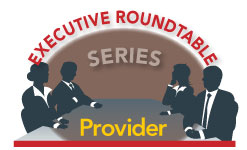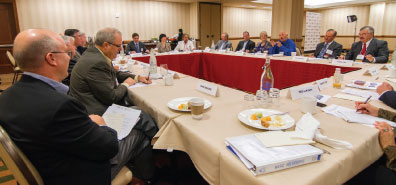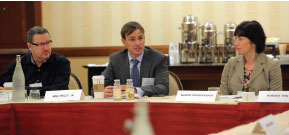Offering innovative solutions for quality care across the spectrum of settings, even when it means creating partnerships with unorthodox entities, will result in more successful managed care relationships, participants at Provider’s Executive Roundtable in October concluded. The roundtable was sponsored by American HealthTech.

In California, for example, two nursing home providers are considering the addition of adult day health care services and a geriatric care practice to their buildings. “You have to look at repurposing the building,” says Jim Gomez, president and chief executive officer (CEO) of the California Association of Health Facilities. “Two of my members are coming together and repurposing their space. I’m talking about taking part of their building and putting a geriatric practice into it for adult day health care. So they will have a better link to the community, provide a wide range of services, and it will bring flow to them.”
The benefit of this, says Gomez, is so that when providers are working with health maintenance, managed care, or accountable care organizations, they can they have a doctor’s office, long term care services, and adult day health care all in one building.
“You can say, ‘I can take care of the patient throughout this,’” says Gomez, who negotiated for an HMO for many years and notes that “they will look to you for solutions, and when you come up with a solution you may be able to capture a significant amount of the marketplace because you are doing more than just the typical long term care provider.”
Building on the concept of innovation and serving the community, Medicalodges Chief Operating Officer Fred Benjamin sees a “great opportunity” for providers with regard to Medicaid programs.
“In Kansas, the program serves many kinds of subpopulations, including frail elderly and women and children. And it goes to creating different kinds of programs—dialysis, for example, home health, and if you have extra land, creating a low-cost senior apartment building on the campus,” he says. “It’s all about serving the managed care company as your customer. They have issues they want to take care of with these subpopulations … and we can create a series of programs that solve their problems and their issues.”
 Summing up the consensus was Ken Lund, president and CEO of Kennon S. Shea and Associates: “Ultimately, [MCOs] are like any other customer. They want you to create the solution, they want it to be affordable, and probably equally important, they want it to be easy and convenient.”
Summing up the consensus was Ken Lund, president and CEO of Kennon S. Shea and Associates: “Ultimately, [MCOs] are like any other customer. They want you to create the solution, they want it to be affordable, and probably equally important, they want it to be easy and convenient.”
Lund described an innovation that he says has been very successful for his company. “The model we’ve built is to deliver a continuum with a single point of entry so that whoever is the trusted advisor of the patient, when they come to us, we don’t have to say ‘we’ve got these skilled beds for you.’ Instead, we can say, ‘where do you want to go in the continuum?’” he says.
“We’ve literally tried to abolish the word discharge in our vernacular, because what we really see as our opportunity is being able to follow that patient through a lifetime rather than just through an episode. We’re finding that very effective because we bought a home health care company, and in 10 months it’s our single largest operation without doing any external marketing.”
Garen Cox, president and CEO of Medicalodges, explained that a majority of his companies’ buildings are in rural areas where the hospitals are struggling.
“So we’ve spent a lot of time building a backbone to our infrastructure … and we’ve found ourselves becoming the health center for the community.

“We are not only the largest employer in some of these areas, but we’re the place where folks go for health care,” he says. “So, in some of our facilities we’ve looked at bringing in physicians to operate a clinic out of the centers. We’re also partnering with other entities to offer other services.”
Gomez took this concept a step further with the suggestion that providers consider partnering with federally qualified health centers. “If there’s a center out there that wants to expand, some of our members are considering housing the community center in an empty wing,” he says. “You then get people coming into the facility and developing that community relationship.”
Visit our YouTube channel to see interviews with roundtable participants.